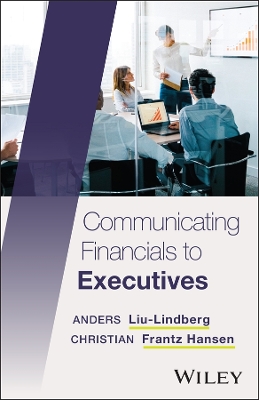Communicating Financials to Executives
 portes grátis
portes grátis
Communicating Financials to Executives
Hansen, Christian Frantz; Liu-Lindberg, Anders
John Wiley & Sons Inc
04/2025
304
Mole
Inglês
9781394292608
Pré-lançamento - envio 15 a 20 dias após a sua edição
Descrição não disponível.
Preface: Our experience with financial communication. 5
Chp. 1 Why Financial Communication to Executives Requires Special Attention. 8
The Pressure is Mounting on Executives. 9
Insight X Influence = Impact 10
The Purpose of Finance. 12
The Value of Finance. 14
The Intrinsic Motivation for Finance Professionals. 15
The Job is on the Line. 17
All We Need is a Framework for Financial Communication. 18
Chp. 2 The Struggles of Finance Professionals to Communicate Financials. 19
The Three Main Challenges. 20
Sharing Too Many Details. 21
Having No Consistent Structure. 23
Making No Apparent Recommendations. 25
Meet Sarah, a Senior Financial Analyst 27
Chp. 3 Five Steps for Communicating Financials to Executives. 28
Take a Customer-Centric Approach. 29
From Data to Insights. 31
Five Steps for Financial Communication to Executives. 33
Info. 34
Insights. 35
Recommendation. 36
Evidence. 37
Action. 39
Sarah Gets to Know Her Customers. 40
Chp. 4 Step 1: Information: What is the Financial Status. 42
Define an Objective and Target Stakeholder. 43
Data Extraction: Access Relevant Data Sources. 46
Data Preparation: Build on a Proper Foundation. 47
Data Analysis: Extracting Relevant Insights. 50
Data Selection: Present Only What Matters. 57
Moving from Information to Insights. 59
Sarah's Data Struggle. 59
Chp. 5 Step 2: Insights: What Are the Key Attention Points?. 61
What is an Insight?. 62
Cater to Your Audience. 65
Empathy: Present Insights Relevant to Your Stakeholders. 66
Types of Analytics. 72
Tips to Communicate Your Insights. 76
Moving from Insights to Recommendations. 82
Sarah Uncovers the Root Causes of Poor Revenue Performance. 83
Chp 6. Step 3: Resolution: What Can We Do About It?. 85
Distinguish Between Output and Outcomes. 87
Dare to Have an Opinion. 89
Leverage Structured Problem-Solving. 90
Tips for Making a Recommendation. 97
Supporting Your Recommendation with Arguments. 99
Sarah Ideates Potential Solutions. 99
Chp. 7 Step 4: Argumentation: Why Is This a Good Idea?. 102
The Difference Between Argument and Facts. 102
The Magic Number of Three: Why Three Arguments Are Ideal 105
Expanding the Definition of Facts Beyond Numbers. 108
The Importance of Selectivity. 111
From Argument to Decision. 113
Sarah Backs Up Her Recommendation. 114
Chp. 8 Step 5: How Do We Get Started. 116
Summarize and Ensure a Common Understanding. 116
Anticipate Change Resistance. 117
Pave the Way Forward. 121
Insist on a Decision: Turning Discussion into Action. 122
Getting Started with the New Sales Channel 125
Chp. 9 Considerations on Data Visualizations. 128
Make It Easy to Decode Your Key Message. 130
System 1 and System 2 Thinking. 131
Pre-Attentive Attributes and Gestalt Principles. 136
Chp. 10 How to Prepare the Perfect Management Report 145
Structuring Your Management Report 147
A Mock-Up of the Perfect Management Report 149
Chp. 11 How Finance Professionals Become Excellent Communicators. 157
Business Cases. 161
From Analysis to Presentation. 163
One Size Does Not Fit All 164
Final Tips on Communication. 165
Chp. 12 Practical Steps to Start Improving Your Communication Skills. 168
Taking the First Steps. 169
The Next Steps. 171
From Steps to a New Company Culture. 173
It is Time to Get to Work. 174
Chp. 1 Why Financial Communication to Executives Requires Special Attention. 8
The Pressure is Mounting on Executives. 9
Insight X Influence = Impact 10
The Purpose of Finance. 12
The Value of Finance. 14
The Intrinsic Motivation for Finance Professionals. 15
The Job is on the Line. 17
All We Need is a Framework for Financial Communication. 18
Chp. 2 The Struggles of Finance Professionals to Communicate Financials. 19
The Three Main Challenges. 20
Sharing Too Many Details. 21
Having No Consistent Structure. 23
Making No Apparent Recommendations. 25
Meet Sarah, a Senior Financial Analyst 27
Chp. 3 Five Steps for Communicating Financials to Executives. 28
Take a Customer-Centric Approach. 29
From Data to Insights. 31
Five Steps for Financial Communication to Executives. 33
Info. 34
Insights. 35
Recommendation. 36
Evidence. 37
Action. 39
Sarah Gets to Know Her Customers. 40
Chp. 4 Step 1: Information: What is the Financial Status. 42
Define an Objective and Target Stakeholder. 43
Data Extraction: Access Relevant Data Sources. 46
Data Preparation: Build on a Proper Foundation. 47
Data Analysis: Extracting Relevant Insights. 50
Data Selection: Present Only What Matters. 57
Moving from Information to Insights. 59
Sarah's Data Struggle. 59
Chp. 5 Step 2: Insights: What Are the Key Attention Points?. 61
What is an Insight?. 62
Cater to Your Audience. 65
Empathy: Present Insights Relevant to Your Stakeholders. 66
Types of Analytics. 72
Tips to Communicate Your Insights. 76
Moving from Insights to Recommendations. 82
Sarah Uncovers the Root Causes of Poor Revenue Performance. 83
Chp 6. Step 3: Resolution: What Can We Do About It?. 85
Distinguish Between Output and Outcomes. 87
Dare to Have an Opinion. 89
Leverage Structured Problem-Solving. 90
Tips for Making a Recommendation. 97
Supporting Your Recommendation with Arguments. 99
Sarah Ideates Potential Solutions. 99
Chp. 7 Step 4: Argumentation: Why Is This a Good Idea?. 102
The Difference Between Argument and Facts. 102
The Magic Number of Three: Why Three Arguments Are Ideal 105
Expanding the Definition of Facts Beyond Numbers. 108
The Importance of Selectivity. 111
From Argument to Decision. 113
Sarah Backs Up Her Recommendation. 114
Chp. 8 Step 5: How Do We Get Started. 116
Summarize and Ensure a Common Understanding. 116
Anticipate Change Resistance. 117
Pave the Way Forward. 121
Insist on a Decision: Turning Discussion into Action. 122
Getting Started with the New Sales Channel 125
Chp. 9 Considerations on Data Visualizations. 128
Make It Easy to Decode Your Key Message. 130
System 1 and System 2 Thinking. 131
Pre-Attentive Attributes and Gestalt Principles. 136
Chp. 10 How to Prepare the Perfect Management Report 145
Structuring Your Management Report 147
A Mock-Up of the Perfect Management Report 149
Chp. 11 How Finance Professionals Become Excellent Communicators. 157
Business Cases. 161
From Analysis to Presentation. 163
One Size Does Not Fit All 164
Final Tips on Communication. 165
Chp. 12 Practical Steps to Start Improving Your Communication Skills. 168
Taking the First Steps. 169
The Next Steps. 171
From Steps to a New Company Culture. 173
It is Time to Get to Work. 174
Este título pertence ao(s) assunto(s) indicados(s). Para ver outros títulos clique no assunto desejado.
executive communication; finance executive; business communication; financial communication; management report; business presentation; financial presentation; accounting presentation; accounting data; accounting report
Preface: Our experience with financial communication. 5
Chp. 1 Why Financial Communication to Executives Requires Special Attention. 8
The Pressure is Mounting on Executives. 9
Insight X Influence = Impact 10
The Purpose of Finance. 12
The Value of Finance. 14
The Intrinsic Motivation for Finance Professionals. 15
The Job is on the Line. 17
All We Need is a Framework for Financial Communication. 18
Chp. 2 The Struggles of Finance Professionals to Communicate Financials. 19
The Three Main Challenges. 20
Sharing Too Many Details. 21
Having No Consistent Structure. 23
Making No Apparent Recommendations. 25
Meet Sarah, a Senior Financial Analyst 27
Chp. 3 Five Steps for Communicating Financials to Executives. 28
Take a Customer-Centric Approach. 29
From Data to Insights. 31
Five Steps for Financial Communication to Executives. 33
Info. 34
Insights. 35
Recommendation. 36
Evidence. 37
Action. 39
Sarah Gets to Know Her Customers. 40
Chp. 4 Step 1: Information: What is the Financial Status. 42
Define an Objective and Target Stakeholder. 43
Data Extraction: Access Relevant Data Sources. 46
Data Preparation: Build on a Proper Foundation. 47
Data Analysis: Extracting Relevant Insights. 50
Data Selection: Present Only What Matters. 57
Moving from Information to Insights. 59
Sarah's Data Struggle. 59
Chp. 5 Step 2: Insights: What Are the Key Attention Points?. 61
What is an Insight?. 62
Cater to Your Audience. 65
Empathy: Present Insights Relevant to Your Stakeholders. 66
Types of Analytics. 72
Tips to Communicate Your Insights. 76
Moving from Insights to Recommendations. 82
Sarah Uncovers the Root Causes of Poor Revenue Performance. 83
Chp 6. Step 3: Resolution: What Can We Do About It?. 85
Distinguish Between Output and Outcomes. 87
Dare to Have an Opinion. 89
Leverage Structured Problem-Solving. 90
Tips for Making a Recommendation. 97
Supporting Your Recommendation with Arguments. 99
Sarah Ideates Potential Solutions. 99
Chp. 7 Step 4: Argumentation: Why Is This a Good Idea?. 102
The Difference Between Argument and Facts. 102
The Magic Number of Three: Why Three Arguments Are Ideal 105
Expanding the Definition of Facts Beyond Numbers. 108
The Importance of Selectivity. 111
From Argument to Decision. 113
Sarah Backs Up Her Recommendation. 114
Chp. 8 Step 5: How Do We Get Started. 116
Summarize and Ensure a Common Understanding. 116
Anticipate Change Resistance. 117
Pave the Way Forward. 121
Insist on a Decision: Turning Discussion into Action. 122
Getting Started with the New Sales Channel 125
Chp. 9 Considerations on Data Visualizations. 128
Make It Easy to Decode Your Key Message. 130
System 1 and System 2 Thinking. 131
Pre-Attentive Attributes and Gestalt Principles. 136
Chp. 10 How to Prepare the Perfect Management Report 145
Structuring Your Management Report 147
A Mock-Up of the Perfect Management Report 149
Chp. 11 How Finance Professionals Become Excellent Communicators. 157
Business Cases. 161
From Analysis to Presentation. 163
One Size Does Not Fit All 164
Final Tips on Communication. 165
Chp. 12 Practical Steps to Start Improving Your Communication Skills. 168
Taking the First Steps. 169
The Next Steps. 171
From Steps to a New Company Culture. 173
It is Time to Get to Work. 174
Chp. 1 Why Financial Communication to Executives Requires Special Attention. 8
The Pressure is Mounting on Executives. 9
Insight X Influence = Impact 10
The Purpose of Finance. 12
The Value of Finance. 14
The Intrinsic Motivation for Finance Professionals. 15
The Job is on the Line. 17
All We Need is a Framework for Financial Communication. 18
Chp. 2 The Struggles of Finance Professionals to Communicate Financials. 19
The Three Main Challenges. 20
Sharing Too Many Details. 21
Having No Consistent Structure. 23
Making No Apparent Recommendations. 25
Meet Sarah, a Senior Financial Analyst 27
Chp. 3 Five Steps for Communicating Financials to Executives. 28
Take a Customer-Centric Approach. 29
From Data to Insights. 31
Five Steps for Financial Communication to Executives. 33
Info. 34
Insights. 35
Recommendation. 36
Evidence. 37
Action. 39
Sarah Gets to Know Her Customers. 40
Chp. 4 Step 1: Information: What is the Financial Status. 42
Define an Objective and Target Stakeholder. 43
Data Extraction: Access Relevant Data Sources. 46
Data Preparation: Build on a Proper Foundation. 47
Data Analysis: Extracting Relevant Insights. 50
Data Selection: Present Only What Matters. 57
Moving from Information to Insights. 59
Sarah's Data Struggle. 59
Chp. 5 Step 2: Insights: What Are the Key Attention Points?. 61
What is an Insight?. 62
Cater to Your Audience. 65
Empathy: Present Insights Relevant to Your Stakeholders. 66
Types of Analytics. 72
Tips to Communicate Your Insights. 76
Moving from Insights to Recommendations. 82
Sarah Uncovers the Root Causes of Poor Revenue Performance. 83
Chp 6. Step 3: Resolution: What Can We Do About It?. 85
Distinguish Between Output and Outcomes. 87
Dare to Have an Opinion. 89
Leverage Structured Problem-Solving. 90
Tips for Making a Recommendation. 97
Supporting Your Recommendation with Arguments. 99
Sarah Ideates Potential Solutions. 99
Chp. 7 Step 4: Argumentation: Why Is This a Good Idea?. 102
The Difference Between Argument and Facts. 102
The Magic Number of Three: Why Three Arguments Are Ideal 105
Expanding the Definition of Facts Beyond Numbers. 108
The Importance of Selectivity. 111
From Argument to Decision. 113
Sarah Backs Up Her Recommendation. 114
Chp. 8 Step 5: How Do We Get Started. 116
Summarize and Ensure a Common Understanding. 116
Anticipate Change Resistance. 117
Pave the Way Forward. 121
Insist on a Decision: Turning Discussion into Action. 122
Getting Started with the New Sales Channel 125
Chp. 9 Considerations on Data Visualizations. 128
Make It Easy to Decode Your Key Message. 130
System 1 and System 2 Thinking. 131
Pre-Attentive Attributes and Gestalt Principles. 136
Chp. 10 How to Prepare the Perfect Management Report 145
Structuring Your Management Report 147
A Mock-Up of the Perfect Management Report 149
Chp. 11 How Finance Professionals Become Excellent Communicators. 157
Business Cases. 161
From Analysis to Presentation. 163
One Size Does Not Fit All 164
Final Tips on Communication. 165
Chp. 12 Practical Steps to Start Improving Your Communication Skills. 168
Taking the First Steps. 169
The Next Steps. 171
From Steps to a New Company Culture. 173
It is Time to Get to Work. 174
Este título pertence ao(s) assunto(s) indicados(s). Para ver outros títulos clique no assunto desejado.




